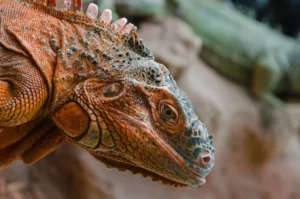0

The common green iguana is a subspecies of red iguanas.
Due to its distinctive red color, the red iguana, a member of the Iguanidae family, has experienced a sharp rise in popularity. The red iguana is a kind of the common green iguana, which many people are unaware of. A selective breeding method that targeted the alteration of the color gene produced the red color.
The red iguana usually has some green on its bottom, but the amount can vary from a few tiny patches to a completely green underside.
Iguanas can grow to be very large. This may be a consideration for anyone thinking about keeping one as a pet.
Some of the larger species have astounding heights of 7 feet (2 meters). Plus weights of around 18 pounds (8 kg).
The dewlap and dorsal crest of the species’ males are often larger than those of the females, which helps to identify them. The reproductive organs are in a protrusion behind the vent in males.

Iguanas have a row of spines running from the base of the skull to the tip of the tail. And this is true of both male and female iguanas. Iguanas have long, slender bodies with soft scales.
Additionally, they have five lengthy toes that have somewhat sharp claws to help them climb in their natural environment.
The common green iguana is a native of Central and South America. Whereas the red iguana is a phenomenon in captive breeding projects. Green iguanas are frequently seen in rivers and wetlands because they like regions with both trees and a water source.
These iguanas are gregarious creatures that typically reside in groups in their native habitat. Males often display territorial behavior and engage in conflict over the best basking locations.
The green and red iguanas are relatively simple to maintain in captivity, but they do need some recreation of their original habitat. Iguanas prefer both direct sunlight and the shade that treetops offer, therefore their cage should only have lighting on one side.
A water source and routine hand misting of the iguana help to maintain humidity levels. UVA and UBV heat bulbs should help to control the enclosure’s temperature.
Although red and green iguanas belong to the same species, they differ from each other in other ways as well, including their distinctive hue.
Red iguanas are at the top of the length continuum, with many easily exceeding the seven-foot threshold by full adulthood, while green iguanas typically measure between five and six feet long when completely grown.
Usually, males grow bigger than girls do. The iguana’s body will continue to expand, and many adults can weigh up to 20 pounds.
If you buy an iguana as a baby, its size will alter significantly over the course of its life. Iguana hatchlings are only six inches long. Iguanas don’t reach their full size until they are between five and six years old. It’s a popular misconception that iguanas can only get as big as their cage, but this is untrue.
Remember the final size of the adult animal when selecting whether or not to bring an iguana home with you, and make sure to prepare appropriately.
A sizable cage is necessary to provide for an iguana in its full adult size.
Juveniles can be in a regular terrarium tank, but as adults, they need a cage that is roughly six feet tall, six feet wide, and four feet deep. Glass containers are inadequate for this use because a large enclosure made entirely of glass would be difficult to maintain.
Although there are some pre-made cages constructed specifically for iguanas available at pet stores and online, custom-built enclosures made from a mixture of wood, plexiglass, and wire are frequently the best option.
The same level of care is key for red and ordinary green iguanas. Anyone who buys an iguana should be aware of its demands from the beginning because they are so enormous and can live for up to 20 years. When they are young, young iguanas need to be handled and trained to react appropriately to humans.
When they reach their adult size, this serves to prevent them from lashing out at their human caretakers.
Because they require patience and might be dangerous if handled improperly, they are typically better suited for adult caregivers than children.
They make wonderful companions when properly socialized with people, and they may even be able to know the faces of those who look after them.
Maintaining the right temperature and lighting levels is a vital element of taking care of your iguana. The lizard will benefit from being in a cage that receives natural light, if at all feasible. Reptile bulbs that you can get at pet stores should help in addition to natural light.
Since iguanas like warm, tropical climes, it is vital to provide heating lamps. A tank should have a hot side and a cool side so the iguana may adjust the temperature as necessary. For it to be comfortable, the daytime temperature needs to be a little bit higher than 90 degrees.

Greens, fruits, and vegetables must be a part of an iguana’s diet.
Since they are herbivores, they won’t need to eat insects or other sources of protein that are frequently found in the diets of some other species of pet lizards. A diet for iguanas should mostly consist of chopped greens.
In addition to adding vegetables, like broccoli, you may also add more greens. Include fruits in the diet as a treat, but they shouldn’t make up a significant amount of it.
Additionally, you must offer the iguana fresh water every day that is chlorine-free. You might add some fruits or vegetables to the water bowl to encourage your pet to drink.
To avoid forgetting anything, it is a good idea to establish a daily schedule for feeding and replacing the iguana’s water.